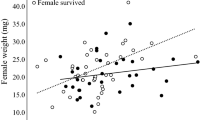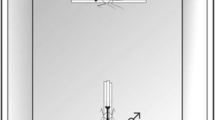Abstract
Cannibalism is hypothesized to have evolved as a way to obtain a high-quality meal. We examined the extraction of lipid and protein by female wolf spiders, Hogna helluo, during sexual cannibalism of males and predation of crickets. Most food-limited females did not cannibalize males but immediately consumed a size-matched cricket. When consuming male H. helluo and crickets, female H. helluo only consumed 51% of the male body while they consumed 72% of the cricket body. While males had higher protein content in their bodies than crickets and other insects, female H. helluo ingested similar amounts of protein from male H. helluo and crickets. Female H. helluo extracted 47% of the protein present in male H. helluo and 67% of the protein present in crickets. Females were able to extract nearly all of the lipid present in male H. helluo and crickets. However, crickets and other insects had almost 4 times higher lipid content than male H. helluo. The ratio of lipid to protein consumed from crickets appeared more similar to the nutritional requirements of egg production than that of males. Taken together, female hesitancy to engage in cannibalism, low extraction of nutrients from males and a low ratio of lipid to protein in the food extracted from males suggest that males may be poor-quality prey items compared to common insects such as crickets.




Similar content being viewed by others

References
Andrade MCB (1996) Sexual selection for male sacrifice in the Australian redback spider. Science 271:70–72
Arnqvist G, Henriksson S (1997) Sexual cannibalism in the fishing spider and a model for the evolution of sexual cannibalism based on genetic constraints. Evol Ecol 11:255–273
Barry KL, Holwell GI, Herberstein ME (2009) Female praying mantids use sexual cannibalism as a foraging strategy to increase fecundity. Behav Ecol
Bernard JB, Allen ME (1997) Feeding captive insectivorous animals: nutritional aspects of insects as food. Nutrition Advisory Group, American Zoo and Aquarium Association
Birkhead TR, Lee KE, Young P (1988) Sexual cannibalism in the praying mantid Hierodula membranacea. Behavior 106:112–118
Calow P (1979) The cost of reproduction: a physiological approach. Biol Rev 54:23–40
Casas J, Pincebourde S, Mandon N, Vannier F, Poujol R, Giron D (2005) Lifetime nutrient dynamics reveal simultaneous capital and income breeding in a parasitoid. Ecology 86:545–554
Cohen AC (1995) Extraoral digestion in predaceous terrestrial arthropoda. Annu Rev Entomol 40:85–103
Crump ML (1990) Possible enhancement of growth in tadpoles through cannibalism. Copeia 2:560–564
Denno RF, Fagan WF (2003) Might nitrogen limitation promote omnivory among carnivorous arthropods? Ecology 84:2522–2531
Elgar MA, Crespi BJ (1992) Cannibalism: ecology and evolution among diverse taxa. Oxford University Press, New York
Elgar MA, Schneider JM (2004) Evolutionary significance of sexual cannibalism. Adv Stud Behav 34:135–163
Elgar MA, Schneider JM, Herberstein ME (2000) Female control of paternity in the sexually cannibalistic spider Argiope keyserlingi. Proc R Soc Lond B 267:2439–2443
Fagan WF, Denno RF (2004) Stoichiometry of actual versus potential predator-prey interactions: insights into nitrogen limitation for arthropod predators. Ecol Lett 7:876–883
Fagan WF, Siemann E, Mitter C, Denno RF, Huberty AF, Woods HA, Elser JJ (2002) Nitrogen in insects: implications for trophic complexity and species diversification. Am Nat 160:784–802
Fahey BF, Elgar MA (1997) Sexual cohabitation as mate-guarding in the leaf-curling spider Phonognatha graeffei Keyserling (Araneoidea, Araneae). Behav Ecol Sociobiol 40:127–133
Fromhage L, Uhl G, Schneider JM (2003) Fitness consequences of sexual cannibalism in female Argiope bruennichi. Behav Ecol Sociobiol 55:60–64
Gende SM, Quinn TP, Willson MF (2001) Consumption choice by bears feeding on salmon. Oecologia 127:372–382
Harshman LG, Zera AJ (2007) The cost of reproduction: the devil in the details. Trends Ecol Evol 22:80–86
Helms KR, Vinson SB (2002) Widespread association of the invasive ant Solenopsis invicta with an invasive mealybug. Ecology 83:2425–2438
Horowitz H (2002) Official methods of analysis of the AOAC International. AOAC, Gaithersburg
Howard LO (1886) The excessive voracity of the female mantis. Science 8:326
Hunt J, Brooks R, Jennions MD, Smith MJ, Bentsen CL, Bussiere LF (2004) High-quality male field crickets invest heavily in sexual display but die young. Nature 432:1024–1027
Johnson JC (2001) Sexual cannibalism in fishing spiders (Dolomedes triton): an evaluation of two explanations for female aggresstion towards potential mates. Anim Behav 61:905–914
Johnson JC, Sih A (2005) Precopulatory sexual cannibalism in fishing spiders (Dolomedes triton): a role for behavioral syndromes. Behav Ecol Sociobiol 58:390–396
Knoflach B, Van Harten A (2001) Tidarren argo sp Nov (Araneae: Theridiidae) and its exceptional copulatory behaviour: emasculation, male palpal organ as a mating plug and sexual cannibalism. J Zool 254:449–459
Matsumura M, Trafelet-Smith GM, Gratton C, Finke DL, Fagan WF, Denno RF (2004) Does intraguild predation enhance predator performance: a stoichiometric perspective. Ecology 85:2601–2615
Maxwell MR (1999) The risk of cannibalism and male mating behavior in the Mediterranean praying mantid, Iris oratoria. Behaviour 136:205–219
Maxwell MR (2000) Does a single meal affect female reproductive output in the sexually cannibalistic praying mantid Iris oratoria? Ecol Entomol 25:54–62
Mayntz D, Toft S (2001) Nutrient composition of the prey’s diet affects growth and survivorship of a generalist predator. Oecologia 127:207–213
Mayntz D, Toft S (2006) Nutritional value of cannibalism and the role of starvation and nutrient imbalance for cannibalistic tendencies in a generalist predator. J Anim Ecol 75:288–297
Mayntz D, Raubenheimer D, Salomon M, Toft S, Simpson SJ (2005) Nutrient-specific foraging in invertebrate predators. Science 307:111–113
Meffe GK, Crump ML (1987) Possible growth and reproductive benefits of cannibalism in the mosquitofish. Am Nat 129:203–212
Nentwig W (1986) Non-webbuilding spiders: prey specialists or generalists? Oecologia 69:571–576
Nyffeler M, Benz B (1988) Feeding ecology and predatory importance of wolf spiders (Pardosa spp.) (Araneae, Lycosidae) in winter wheat fields. J Appl Entomol 106:123–134
Paine RT (1971) The measurement and application of the calorie to ecological problems. Annu Rev Ecol Syst 2:145–164
Pfennig DW (2000) Effect of predator-prey phylogenetic distance on the fitness consequences of predation: a tradeoff between nutrition and disease? Am Nat 155:335–345
Polis GA, Myers CA, Holt RD (1989) The ecology and evolution of intraguild predation: potential competitors that eat each other. Annu Rev Ecol Syst 20:297–330
Prete FR, Wolfe MM (1992) Religious supplicant, seductive cannibal, or reflex machine: in search of the praying mantis. J Hist Biol 25:91–136
Rabaneda-Bueno R, Rodriguez-Girones MA, Aguado-de-la-Paz S, Fernandez-Montraveta C, De Mas E, Wise DH, Moya-Larano J (2008) Sexual cannibalism: high incidence in a natural population with benefits to females. PLoS ONE 3:e3484
Ramos-Elorduy J, Moreno JMP, Prado EE, Perez MA, Otero JL, de Guevara OL (1997) Nutritional value of edible insects from the State of Oaxaca, Mexico. J Food Compos Anal 10:142–157
Raubenheimer D, Mayntz D, Simpson SJ, Toft S (2007) Nutrient-specific compensation following diapauses in a predator: implications for intraguild predation. Ecology 88:2598–2608
Rickers S, Langel R, Scheu S (2006) Dietary routing of nutrients from prey to offspring in a generalist predator: effects of prey quality. Funct Ecol 20:124–131
Rudolf VHW (2007) The interaction of cannibalism and omnivory: consequences for community dynamics. Ecology 88:2697–2705
Rudolf VHW (2008) The impact of cannibalism on predator-prey dynamics: size-structured interactions and apparent mutualism. Ecology 89:1650–1660
Salomon M, Mayntz D, Lubin Y (2008) Colony nutrition skews reproduction in a social spider. Behav Ecol 19:605–611
Schausberger P, Croft BA (2000) Nutritional benefits of intraguild predation and cannibalism among generalist and specialist phytoseiid mites. Ecol Entomol 25:473–480
Schneider JM, Elgar MA (2001) Sexual cannibalism and sperm competition in the golden orb-web spider Nephila plumipes (Araneoidea): female and male perspectives. Behav Ecol 12:547–552
Snyder WE, Joseph SB, Preziosi RF, Moore AJ (2000) Nutritional benefits of cannibalism for the lady beetle Harmonia axyridis (Coleoptera: Coccinellidae) when prey quality is poor. Environ Entomol 29:1173–1179
Sokol-Hessner L, Schmitz OJ (2002) Aggregate effects of multiple predator species on a shared prey. Ecology 83:2367–2372
Spence JR, Zimmermann M, Wojcicki JP (1996) Effects of food limitation and sexual cannibalism on reproductive output of the nursery web spider Dolomedes triton (Araneae: Pisauridae). Oikos 75:373–382
Stalhandske P (2001) Nuptial gift in the spider Pisaura mirabilis maintained by sexual selection. Behav Ecol 12:691–697
Wackers FL, van Rijn PCJ, Bruin J (2005) Plant provided food for carnivorous insects: a protective mutualism and its applications. Cambridge University Press, Cambridge
White TCR (1978) The importance of a relative shortage of food in animal ecology. Oecologia 33:71–86
Wilder SM, Rypstra AL (2008a) Sexual size dimorphism predicts sexual cannibalism in spiders. Am Nat 172:431–440
Wilder SM, Rypstra AL (2008b) Diet quality affects mating behaviour and egg production in a wolf spider. Anim Behav 76:439–445
Wilder SM, Rypstra AL (2008c) Sexual size dimorphism mediates the occurrence of state-dependent sexual cannibalism in a wolf spider. Anim Behav 76:447–454
Wilder SM, Rypstra AL (2008d) Prior encounters with the opposite sex affect male and female mating behavior in a wolf spider (Araneae, Lycosidae). Behav Ecol Sociobiol 62:1813–1820
Wilder SM, Rypstra AL, Elgar MA (2009a) The roles of ecological and phylogenetic factors for the occurrence and frequency of sexual cannibalism. Annu Rev Ecol Evol Syst 40
Wilder SM, Mayntz D, Toft S, Rypstra AL, Pilati A, Vanni MJ (2009b) Intraspecific variation in the quality of prey: a comparison of nutrient presence in prey and nutrient extraction by spiders. Oikos (in press)
Williams GC (1966) Natural selection, the costs of reproduction, and a refinement of Lack’s principle. Am Nat 100:687–690
Wise DH (1993) Spiders in ecological webs. Cambridge University Press, Cambridge
Wise DH (2006) Cannibalism, food limitation, intraspecific competition, and the regulation of spider populations. Annu Rev Entomol 51:441–465
Yasuda H, Ohnuma N (1999) Effects of cannibalism and predation on the larval performance of two ladybird beetles. Entomol Exp Appl 93:63–67
Acknowledgments
We thank J. Moya-Larano and D. H. Wise for comments on a previous draft of this manuscript. We also thank members of the Miami University Spider Lab for collecting and maintaining spiders used in these experiments. Funding was provided by the Department of Zoology at Miami University and by National Science Foundation grant DBI-0216947 to A. L. R.
Author information
Authors and Affiliations
Corresponding author
Additional information
Communicated by Thomas Hoffmeister.
Rights and permissions
About this article
Cite this article
Wilder, S.M., Rypstra, A.L. Males make poor meals: a comparison of nutrient extraction during sexual cannibalism and predation. Oecologia 162, 617–625 (2010). https://doi.org/10.1007/s00442-009-1518-3
Received:
Accepted:
Published:
Issue Date:
DOI: https://doi.org/10.1007/s00442-009-1518-3



